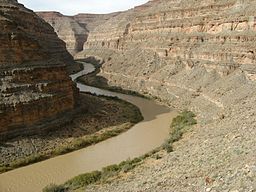San Juan River (Utah)
| San Juan River | |
|
The lower San Juan River in Utah
|
|
| Country | United States |
|---|---|
| States | New Mexico, Colorado, Utah |
| Tributaries | |
| - left | Navajo River, Chinle Creek |
| - right | Piedra River, Los Pinos River, Animas River |
| Source | Rocky Mountains |
| Mouth | Colorado River |
| - location | San Juan County, Utah |
| - coordinates | 37°10′47″N 110°54′03″W / 37.17972°N 110.90083°WCoordinates: 37°10′47″N 110°54′03″W / 37.17972°N 110.90083°W |
| Length | 383 mi (616 km), east-west |
| Basin | 24,600 sq mi (63,714 km2) |
| Discharge | for Bluff, UT (RM 113.5/RKM 182.7) |
| - average | 2,192 cu ft/s (62 m3/s) |
| - max | 70,000 cu ft/s (1,982 m3/s) |
| - min | 0 cu ft/s (0 m3/s) |
|
Map of the San Juan River watershed
|
|
The San Juan River is a significant tributary of the Colorado River in the southwestern United States, about 383 miles (616 km) long. The river drains an area of about 24,600 square miles (64,000 km2) in southwestern Colorado, northwestern New Mexico, southeastern Utah, and a small part of northeastern Arizona. The average flow of the San Juan River at Bluff is about 2,200 cubic feet per second (62 m3/s) and the highest discharge ever measured was about 70,000 cubic feet per second (2,000 m3/s) on September 10, 1927.
The San Juan River joins the Colorado River at Lake Powell, a huge reservoir, and in fact the westmost (and lowest) miles of the San Juan River are impounded by Lake Powell and the Glen Canyon Dam. Most of the San Juan River lies in San Juan County, New Mexico and San Juan County, Utah, which share a boundary of one point at the Four Corners. The San Juan River lies just a few miles northeast of the Four Corners point.
The San Juan River has its source in southwestern Colorado, along the southern slopes of the San Juan Mountains and to the west of the Continental Divide. The San Juan River flows southwesterly into the state of New Mexico, then westerly across New Mexico, and then northwesterly from New Mexico, and for a short distance across the very southwestern corner of Colorado, and then continues in its northwesterly course for an appreciable distance into Utah.
The largest tributary of the San Juan is the Animas River (severely affected by the EPA's accidental August 2015 Gold King Mine waste water spill), followed by the Piedra and Los Pinos rivers. The tributaries of the San Juan River that are located in Colorado also flow from the San Juan Mountains, including the Animas River, the La Plata River, the Los Pinos River, the Navajo River and the Piedra River.
...
Wikipedia


